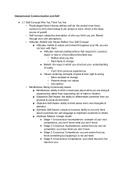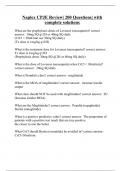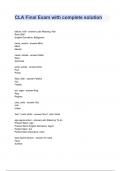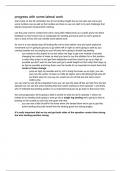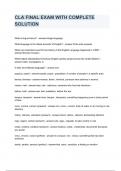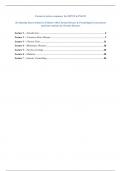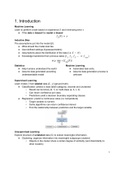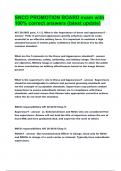Behaviour & environment (in organisations)
Hoorcollege 1 (5-11-2019) – Work & work behaviour (H1):
Work has impact on health, happiness and personality (benefits people):
- Personal finance (independence, availability of new resources)
- Time structure (regular activity)
- Social identity (source of status, self-esteem & happiness)
- Opportunities for social contact (sharing of a common purpose)
- Opportunities for lifelong learning and development
Strategies for hiding feelings:
- Deep acting: the expression is the same as your true feelings gives you
energy
- Surface acting: fake emotions (pretend to be happy/friendly) costs a lot of
energy
Societal dynamics (healthy environment) X Organizational dynamics (productive,
high quality, low costs)
- Intensification: work is becoming more complex, intensive
- Flexibilization: lifelong learning, anticipate on work
- Mentalisation: from working in factories to working with the head
(emotions/knowledge)
- Digitalisation: keep up with technology
- Prolonged working life: later retirement (rising life expectancy costs more)
Healthy life expectancy (it’s not rising to a similar extent, if at all):
- It is strongly related to educational level (high education more options,
better jobs, start later with working, healthier lifestyle)
Four principles ‘Scientific Management’ (1911 - Taylor):
- Scientific approach: time & motion studies (developing more efficient ways of
working)
- Carefully analysing jobs
- Selection of right worker for the job
- Training and development of worker
- Reward employees for productivity, to encourage high levels of performance
Worker is extension of machine workers were exploited protest
Human relations movement (1930 – 1940): more attention to social aspects of work,
two-way communication, good leadership
Organisational psychology (industrialisation): Training & schooling, theories of
leadership, fatigue/stress, preventing accident, ergonomics. Growth of selection
psychology (selection, testing)
Self-determination theory (psychological needs of workers): Autonomy (decide
ourselves what to do & how to do it), Competence (use our skills & competences),
Relatedness (being connected to others, common purpose)
, Hoorcollege 2 (7-11-2019):
Work and health analysis: the systematic collection and assessment of data to form a
judgement about the nature of a task/job and the work-related health of the
employee.
X model of work (determinants of work behaviour):
- Work situation: work demands, work circumstances
(physical), work relationships (leadership, bullying), work
conditions (vacations, overtime work)
- Person: coping capacity, care tasks (kids, groceries),
KSAO (knowledge, skills, abilities (= job performance)
others personal characteristics (= adjustment &
satisfaction))
- Work behaviour: how the work is done, how to deal with problems
- Work performance: the outcome of the work, mistakes
- Personal outcomes: learning, getting tired (burn-out), physical outcomes
Fundamental attribution error: overestimation of personal factors, underestimation of
environmental factors.
Hoorcollege 3 (12-11-2019) – Personnel psychology, Job analysis, selection &
assessment (H3, 4, 5, 6):
Job: position duties task activity ( element)
Job analysis: a method for systemic collection, analysis and description of jobs and
the human attributes they require
- Job-oriented: what do people do in a particular job (information about the
nature of tasks done in the job), a list of duties, tasks, responsibilities,
performance conditions (position (patrol officer), duty (enforce the law), task
(arrests suspect violating the law), activity (driving to suspects house to
arrest), element (place the key in ignition to start the patrol car))
- Person-oriented: a list of the knowledge, skills and personal characteristics
necessary for a person to successfully perform a particular job. KSAO (need to
know on a job (knowledge), what a person is able to do on the job (skill),
persons capability to do job tasks & potential skills (ability), willingness (other))
Goal: Provides clarity on tasks and responsibilities recruitment & selection,
career development (knowledge of KSAO), legal issues (no discrimination,
essential functions), training (needs lecture, modelling, roleplay,
mentoring), performance appraisal (evaluation/assessment of performance),
research
Data collection methods for job analysis:
- Specialist/job analyst: perform the job (for several days)
- Subject matter expert (supervisor & job incumbent): detailed knowledge about
own job or jobs they supervise interviews & questionnaires
- Trained observer: combinations (observing employees doing the job)
Ways to create a job analysis from data:
Hoorcollege 1 (5-11-2019) – Work & work behaviour (H1):
Work has impact on health, happiness and personality (benefits people):
- Personal finance (independence, availability of new resources)
- Time structure (regular activity)
- Social identity (source of status, self-esteem & happiness)
- Opportunities for social contact (sharing of a common purpose)
- Opportunities for lifelong learning and development
Strategies for hiding feelings:
- Deep acting: the expression is the same as your true feelings gives you
energy
- Surface acting: fake emotions (pretend to be happy/friendly) costs a lot of
energy
Societal dynamics (healthy environment) X Organizational dynamics (productive,
high quality, low costs)
- Intensification: work is becoming more complex, intensive
- Flexibilization: lifelong learning, anticipate on work
- Mentalisation: from working in factories to working with the head
(emotions/knowledge)
- Digitalisation: keep up with technology
- Prolonged working life: later retirement (rising life expectancy costs more)
Healthy life expectancy (it’s not rising to a similar extent, if at all):
- It is strongly related to educational level (high education more options,
better jobs, start later with working, healthier lifestyle)
Four principles ‘Scientific Management’ (1911 - Taylor):
- Scientific approach: time & motion studies (developing more efficient ways of
working)
- Carefully analysing jobs
- Selection of right worker for the job
- Training and development of worker
- Reward employees for productivity, to encourage high levels of performance
Worker is extension of machine workers were exploited protest
Human relations movement (1930 – 1940): more attention to social aspects of work,
two-way communication, good leadership
Organisational psychology (industrialisation): Training & schooling, theories of
leadership, fatigue/stress, preventing accident, ergonomics. Growth of selection
psychology (selection, testing)
Self-determination theory (psychological needs of workers): Autonomy (decide
ourselves what to do & how to do it), Competence (use our skills & competences),
Relatedness (being connected to others, common purpose)
, Hoorcollege 2 (7-11-2019):
Work and health analysis: the systematic collection and assessment of data to form a
judgement about the nature of a task/job and the work-related health of the
employee.
X model of work (determinants of work behaviour):
- Work situation: work demands, work circumstances
(physical), work relationships (leadership, bullying), work
conditions (vacations, overtime work)
- Person: coping capacity, care tasks (kids, groceries),
KSAO (knowledge, skills, abilities (= job performance)
others personal characteristics (= adjustment &
satisfaction))
- Work behaviour: how the work is done, how to deal with problems
- Work performance: the outcome of the work, mistakes
- Personal outcomes: learning, getting tired (burn-out), physical outcomes
Fundamental attribution error: overestimation of personal factors, underestimation of
environmental factors.
Hoorcollege 3 (12-11-2019) – Personnel psychology, Job analysis, selection &
assessment (H3, 4, 5, 6):
Job: position duties task activity ( element)
Job analysis: a method for systemic collection, analysis and description of jobs and
the human attributes they require
- Job-oriented: what do people do in a particular job (information about the
nature of tasks done in the job), a list of duties, tasks, responsibilities,
performance conditions (position (patrol officer), duty (enforce the law), task
(arrests suspect violating the law), activity (driving to suspects house to
arrest), element (place the key in ignition to start the patrol car))
- Person-oriented: a list of the knowledge, skills and personal characteristics
necessary for a person to successfully perform a particular job. KSAO (need to
know on a job (knowledge), what a person is able to do on the job (skill),
persons capability to do job tasks & potential skills (ability), willingness (other))
Goal: Provides clarity on tasks and responsibilities recruitment & selection,
career development (knowledge of KSAO), legal issues (no discrimination,
essential functions), training (needs lecture, modelling, roleplay,
mentoring), performance appraisal (evaluation/assessment of performance),
research
Data collection methods for job analysis:
- Specialist/job analyst: perform the job (for several days)
- Subject matter expert (supervisor & job incumbent): detailed knowledge about
own job or jobs they supervise interviews & questionnaires
- Trained observer: combinations (observing employees doing the job)
Ways to create a job analysis from data:


